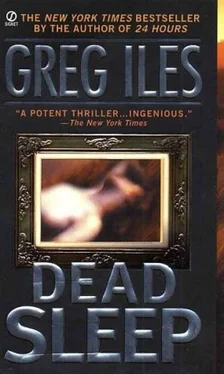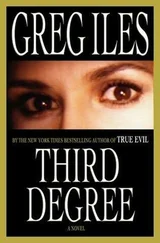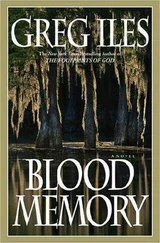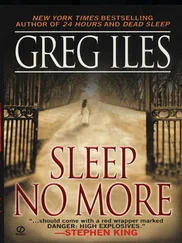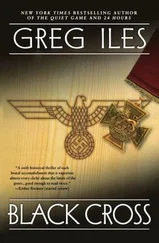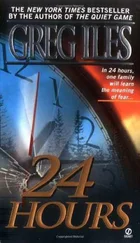John came through surgery fine, but his doctor didn’t want to release him for twenty-four hours. John thanked the man, picked up the cane a physical therapist had deposited in his room, and limped out of the hospital. Assuming I was his spouse – or at least a significant other – the surgeon gave me dire warnings about caring for the wounded leg. I promised to do all I could, then followed John out to a waiting FBI car.
“Where to, sir?” asked the young field agent driving the car. He and John were technically of equal rank, but in times of crisis, a natural hierarchy asserts itself.
“The field office,” John replied. “Move it.”
Baxter, Lenz, and SAC Bowles are waiting for us in Bowles’s office. They’ve spent their last hours in the Emergency Operations Center, but Bowles’s office has a leather chair with an ottoman on which John can prop his swollen leg.
“How is it, John?” Baxter asks as I help him sit down.
“Stiff, but fine.”
Baxter nods in the way I’ve seen officers do when a needed noncom lies about a wound. Nobody’s going to tell John Kaiser to take a medical leave.
“How are you doing, Jordan?”
“Holding it together.”
“I know that wasn’t easy, seeing what happened to Wendy.”
I start to stay silent, but I feel I should say something. “You should know this. She did everything right. The first guy coming toward us looked much more suspicious, and he diverted her. When the well-dressed guy brought up his gun, she threw herself in front of me and was pulling out her gun as she jumped. Nobody could have done better. Nobody.”
Baxter’s jaw muscles clench as pain and pride fight for dominance in his eyes. “This is the first case where I’ve lost an agent to a serial offender,” he says softly. “Now we’ve lost two. It doesn’t need saying, but I’m going to anyway. We will not rest until every son of a bitch involved is rotting in maximum-security lockdown or dead.”
“Amen,” says SAC Bowles. “I’ve got a hundred agents downstairs ready to work twenty-fours a day. Wendy had a lot of friends.”
“We still don’t have his body?” John asks Baxter.
“No. The Coast Guard and contract divers are searching, but the Mississippi is unforgiving. Workers go off barges all the time without being found. We have to accept the possibility that we may never find his body.”
“What about the cell phone?” John asks.
“No prints.”
“No fingerprints on a cell phone? How is that possible?”
“It was wiped clean. He was carrying it wiped. This UNSUB was taking extreme precautions. He must have figured that if he dropped the phone during the abduction, prints would quickly lead to an ID. That’s the good news. I think if we find the body, we’ll get a name in no time.”
“What about the memory chips inside it?”
“The Engineering Research Facility at Quantico just got the phone. They say if the short didn’t fry the chips, we could get lucky. We should get a report anytime.”
Baxter taps his fingertips together like a benched athlete waiting to get back into the game.
“What about my pictures?” I ask.
“That’s the one bright spot. They were blurry but usable. The University of Arizona produced a decent enhancement of the best one, and it’s been running on the local TV stations for two hours. Three calls so far, but they didn’t pan out. The Times-Picayune will run the photo in the morning.”
“Well,” John half-groans. “We got what we wanted. We rattled the hell out of somebody. We just got a delayed reaction, and it was a lot tougher than we expected.”
“Yep,” Baxter agrees.
“What about the UNSUB’s gun?”
Baxter shakes his head. “The river’s high now, and the current fast. Also, the Mississippi has a sandy bottom in some places, and the water flows through it to some depth. Heavy objects sink into it in a matter of seconds. We’re making extraordinary efforts, but again, no great hopes. We have to find that body. Then we can start checking for connections to Wheaton, Gaines, or Smith.”
“Where were the three musketeers while this went down?” John asks.
“All present and accounted for. Wheaton was painting at the art center. Had been since you talked to him this morning. After Jordan left Smith’s house, he lunched at Bayona, shopped at the Hurwitz-Mintz furniture store, then went back home. He’s presently in the company of a handsome young gentleman we’ve yet to identify.”
“And Gaines?”
“Gaines and his girlfriend woke up at ten a.m., started drinking, then arguing. They stopped long enough to have sex, then passed out. They’ve been sleeping ever since.”
“Any of them make suspicious calls?” John asks in a frustrated voice. “Contacts?”
“Nothing.”
“Screw this,” mutters Bowles. “I say we have NOPD pull in all three and sweat them till somebody cracks.”
“I’m worried they may do just that,” says Baxter. “At this point, we have no more leverage to make them talk than we did yesterday. We have to ID the UNSUB and find a connection to one of the three.”
The ISU chief expels air from his cheeks and looks from John to Lenz. “I want to hear thoughts. Anything. Gut feelings, twitches, psychic waves, whatever you’ve got. Now’s the time. What are we dealing with here?”
Neither John nor Lenz seems inclined to speak first, so Baxter points to Lenz. “Arthur? Go out on a limb.”
Silent until now, the psychiatrist leans forward on the sofa. “I see a paradox. One of the UNSUB’s remarks to Jordan could indicate that the previous victims have been raped by the UNSUB, then passed on to the artist to be painted. Yet our art experts say the Sleeping Women weren’t painted by Wheaton, Smith, or Gaines. If you look at what the UNSUB said, it doesn’t exclude the possibility that he himself was the painter.”
I feel compelled to jump in. “I don’t think a man capable of painting the Sleeping Women would refer to them as ‘pretty pictures.’ And when he told me, ‘you’ll still make a pretty picture for the man,’ he could have been talking about a buyer rather than the painter.”
“Marcel de Becque,” says John. “The guy is deep into this thing. I’m not sure how. Maybe three or four guys share a similar paraphilia. I don’t know.”
Baxter’s impatience crackles off him like static electricity. “I can’t believe this is all we have!”
“What about Jordan’s split-personality idea?” John asks. “We didn’t get anything out of Wheaton or Smith on childhood abuse, but that concept has stuck with me. Is it possible that an artist with a split personality could paint in two completely different styles? Undetectably? I mean, how different can the personalities be?”
Lenz steeples his fingers and leans back. “They can be so different as to have different physical manifestations. There are cases of MPD on record where one personality required heart medication to survive, and another did not. One may require corrective lenses and the others not, or need different prescriptions. And there are many lesser manifestations.”
“Come on,” says Bowles.
“Documented fact.” Lenz’s voice has taken on a patronizing tone. “So – two completely different painters occupying the same body? It’s technically possible. But given the scale of this case, the number of victims, the extraordinary lengths to which the dominant personality would have to go to conceal his acts from the others-”
“Wait,” says John. “Not all the personalities know what the others are doing?”
“Correct. Generally one is dominant and knows everything, while the others remain partially in the dark.”
“Jesus,” says Baxter.
Читать дальше
Конец ознакомительного отрывка
Купить книгу
